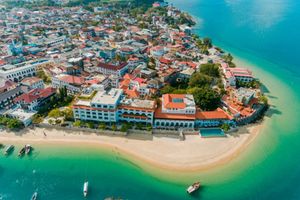On disliking debt-related external financing
What you need to know:
- China seems to be at the centre of these discussions, particularly in the context of lending/borrowing.
In recent days there has been discussions, both in the mainstream as well as social media platforms, with regard to how we Africans finance (and intend to finance) our economic development.
China seems to be at the centre of these discussions, particularly in the context of lending/borrowing.
If we step back and relook on the current state of matters as to how most of developing nations finance their economic activities from the external sources’ paradigm – can we see a better option? According to the 2018 World Investment Report, issued by the United Nations Conference on Trade and Development (UNCTAD) -- developing economies draws on a few external sources of finance, these mainly include Foreign Direct Investment (FDI), Portfolio equity, Long-term and Short-term loans (private and public), Overseas Development Assistance (ODA), as well as Diaspora Remittances.
FDI has been the largest source of external finance over the past decade, and probably the most resilient to economic and financial shocks. To be precise, sources of external financing to Africa stands as follows: ODA & other official flows (36 per cent); Diaspora Remittances (28 per cent); FDIs (21 per cent), Loans and other related investments (14 per cent) as well as Portfolio Investment (1 per cent).
As data indicates, loans are yet to become the main source of external finances to Africa, rather FDIs and Remittances are gaining impact.
The good news here is that the growth of ODA has stagnated over the past decade, currently it amounts to about a quarter of FDI inflows to developing economies. On average, between 2013 and 2017 FDI accounted for 39 per cent of external finance for developing economies.
The other good news is that FDI, being the major source of such financing, does exhibit lower volatility than other sources. Debt-related flows on the other hand are susceptible to sudden stops and reversals – good that it is yet to become major.
And to date, portfolio equity flows account for a low share of external finance to developing economies, especially where capital markets are less developed, like in our case, which is not a good sign, but like debt-related flows, portfolio equity are also considered as relatively unstable because of the speed at which positions can be unwound.
Now, under circumstances where many African countries express their desire to pursue socio-economic development propelled by industrialization and its imbedded structure – if we assume for a minute that we are serious with our intent this time around -- if we think external debt-related finance has some dirty attached into it, where will the financial resources for infrastructure development and industrialization come from?
How can we sustainably finance these industrialization drives? Yes, we know for a fact that any successful and sustainable industrialization policy needs to be preceded and/or accompanied by important development/transformation in the financial sector – but while we are developing the financial sector and its institutions, while we are enhancing national capacities to mobilize financial resources, both domestically and externally, what needs to happen?
If we so much dislike debt-related flows, should it come down to FDIs, Yes? but when it comes to FDIs, wouldn’t it be fair for us then if we seriously consider diverting from resource-seeking FDIs into both “market and efficiency-seeking FDIs”.
Here, history could be a good teacher, that focusing on “resource-seeking FDIs” without strategic diversification seems like not a sensible approach worth pursuing. Currently the stock of FDIs in Africa is estimated at $867 billion; about $83 billion allocated to the East Africa nations and $20 billion of this is in Tanzania.
We know that a significant portion of these FDIs investments are resource and/or commodity-based – actually the decline in FDIs inflows to only about $7.6 billion for the whole of East Africa and $1.2 billion for Tanzania in 2017 relates to this.
That’s why the recent challenge in both demand and pricing of commodity quickly got reflected to the reduction in annual FDI inflows to Africa.
Much as there are expectations FDIs inflows renewals in 2018, but reasons underpinned such hope for recovery are in tied to better commodity prices.
Again, a sensible approach is to create conducive climates to attract such investors from the usual top-10 sources of FDIs for Africa (i.e. US, UK, France, Italy, China, South Africa, Singapore, India, Turkey, etc) to bring their efficiency and market-seeking manufacturing FDIs into textile, automobile, ICT, industrial parks, etc.
If we are hesitant to the market and efficiency seeking FDIs route as well, then a little over a year ago my friends – Ali Mufuruki, Gilman Kasiga, Rahim Mawji and I wrote a book, titled Tanzania’s Industrialization Journey 2016-2056, under the resource mobilization section of the book, we offered some other proposals we thought to practical given our circumstances.
In a relatively lengthy way we labored to explain why we entertained and actually encouraged the idea that we need to proactively and aggressively encourage domestic resources mobilization, basically by strengthen our financial institutions (especially those with long term financing mandates) by enhancing the legal/regulatory and other infrastructure aspects as well as the accompanied financial instruments that will be linked to the practical resource mobilization for industrialization projects and entities that requires such funding.
We also indicated the need for introduction of institutions such as industrial development bank(s) and banks to be more involved and align themselves in the country’s industrialization goals.
We proposed the need for a combination of ownership (between the state, strategic/industrial investors and the public (via IPOs) and management of entities and projects that execute the industrialization programs.
As well as the need to engage the diaspora in our industrialization is not only in financing (through remittances) but also leveraging from their knowledge, skills and experiences.
Mr Marwa is chief executive officer of the Dar es Salaam Stock Exchange Email: [email protected]




